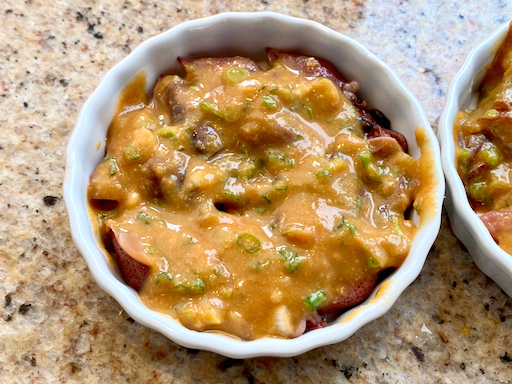It has been customary every year when Easter approaches, for my wife to make hot cross buns (mostly without the sugar frosting cross, because the buns are sweet enough without it). This year was no exception. This year the recipe came from the heavy hard covered cookbook called “Bouchon Bakery Cookbook”. To me, this one looked like the most complicated recipe for hot cross buns I’ve seen my wife make over the years. Nonetheless it tasted very good and had a very nice texture.
Flour 372 g (2 1/2 cups)
Yeast 8 g (2 3/8 tsp)
Sugar 44 g (3 tbs. + 2 tsp)
Salt 9 g (1 1/2 tsp.)
Eggs 186 g (2 eggs)
Whole milk 63 g (1/4 cup)
Butter 167 g (5.8 oz) cut into small cubes
Raisins 122 g (3/4 cup)
Dried cranberries 61 g (1/2 cup)
1 tsp. Vanilla
Ingredients doubled:
Flour 744 g
Yeast 16 g (4 3/4 tsp)
Sugar 88 g (7 tbs. + 1 tsp)
Salt 18 g (3 tsp.)
Eggs 372 g (4 eggs)
Whole milk 126 g (1/2 cup)
Butter 334 g (11 oz) cut into small cubes Raisins 244 g (1 1/2 cups)
Dried cranberries 122 g (1 cup)
2 tsp. Vanilla
Directions:
Combine the fruit in a bowl and pour 2 cups of boiling water over it. Let sit for 5 minutes then drain and pat dry with paper towel. Set aside. Add all the other ingredients but the butter to the bowl of a stand mixer with a dough hook. Mix until a paste-like dough forms. Add the butter a piece at a time and incorporate into the dough. (At this point it will look like that will never happen since there seems to be more butter than flour mixture to incorporate it into.) When all the butter is incorporated mix on speed 2 for 7 to 10 minutes. Pat the dough into a rectangle and spread the fruit evenly over it (#2). Fold the dough into thirds as an envelope fold. Press the dough out into a rectangle again. Turn the dough 180 degrees and do another envelope fold. Press into a rectangle, turn and fold again (#3). Pat into a loaf and place in a lightly oiled bowl turning to coat with the oil and placing it seam side down (#4). Cover and put in proofing box at 75 degrees and let rise for 45 minutes. Remove from bowl and repeat 2 more folds. Return to bowl to rise another 45 minutes. Remove from bowl and divide into 12 equal portions, (24 equal portions for doubled recipe). Roll the divided portions into bun shape and place evenly spaced on a cookie sheet lined with parchment paper. (Next time I will just cut into squares. This will require less working of the dough and make the number of folds more evident in the final product). Cover the pan and let rise until rolls are touching each other. Coat with egg wash and bake in 350 degree oven for 18 to 22 minutes until golden and toothpick comes out clean. Let cool on a rack.
These were indeed fairly complicated muffins. The hardest part was incorporating all the butter. At one point it looked like it wouldn’t happen. But it did. The muffins themselves are luxurious. The texture is dense but very soft. The numerous foldings made very fine layers. They were sweet but not too sweet. (They would have been sweeter if we had added the icing). The fruit adds another texture and a slight vanilla flavor. These are really quite something and worth the effort.

.jpeg)
.jpeg)




.jpeg)
.jpeg)





.jpeg)








